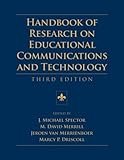Handbook of research on education, communications and technology / edited by J. Michael Spector, M. David Merrill, Jeroen Van Merrienboer, Marcy P. Driscoll.
Material type: TextPublication details: New York : Taylor & Francis, 2008Edition: 3rd edDescription: xxxii, 894 p. : illISBN: 9780805858495 Subject(s): Communication -- Educational aspects -- Research | Education -- Educational aspects -- Research | Technology -- Educational aspects -- ResearchDDC classification: 370.072 Summary: Abstract: Karl Benz’s invention of an automobile with a built-in internal combustion engine in 1885 caused a worldwide revolution, not only in the technological field but also in all segments of human life, such as economics, culture, family structure, urbanization, women and youth emancipation, and climate change. A car, however, seems more suited to solve mobility problems than to serve educational goals. The rise of personal computers and network facilities in the second half of the 20th century eventually converged in a digital World Wide Web (WWW) that revolutionized information development and exchange. Increasing miniaturization, integrated functionalities, and wireless use now comprise a communication hyperspace in a global world. In contrast to the gas-fueled engine, information and communication technologies suggest sensitivity toward lifelong human learning issues. This is what the Handbook of Research on Educational Communications and Technology is all about.
TextPublication details: New York : Taylor & Francis, 2008Edition: 3rd edDescription: xxxii, 894 p. : illISBN: 9780805858495 Subject(s): Communication -- Educational aspects -- Research | Education -- Educational aspects -- Research | Technology -- Educational aspects -- ResearchDDC classification: 370.072 Summary: Abstract: Karl Benz’s invention of an automobile with a built-in internal combustion engine in 1885 caused a worldwide revolution, not only in the technological field but also in all segments of human life, such as economics, culture, family structure, urbanization, women and youth emancipation, and climate change. A car, however, seems more suited to solve mobility problems than to serve educational goals. The rise of personal computers and network facilities in the second half of the 20th century eventually converged in a digital World Wide Web (WWW) that revolutionized information development and exchange. Increasing miniaturization, integrated functionalities, and wireless use now comprise a communication hyperspace in a global world. In contrast to the gas-fueled engine, information and communication technologies suggest sensitivity toward lifelong human learning issues. This is what the Handbook of Research on Educational Communications and Technology is all about.
| Current library | Collection | Call number | URL | Status | Notes | Date due | Barcode |
|---|---|---|---|---|---|---|---|
| UMI Main Library | Non-fiction | 370.072 HAN (Browse shelf(Opens below)) | Link to resource | Available | This book is available ONLINE only. Click on the URL link below to open and read this book. |
Browsing UMI Main Library shelves, Collection: Non-fiction Close shelf browser (Hides shelf browser)

|

|

|

|

|

|

|
||
| 362.1 SCH Introduction to public health / | 368.0068 KRI Value-oriented risk management of insurance companies / | 368.0068 KRI Value-oriented risk management of insurance companies / | 370.072 HAN Handbook of research on education, communications and technology / | 378.6 AJA The African experience with higher education / | 378.6 AJA The African experience with higher education / | 658 MER Management control systems : |
Includes glossary and index.
Abstract: Karl Benz’s invention of an automobile with a built-in internal combustion engine in 1885 caused a worldwide revolution, not only in the technological field but also in all segments of human life, such as economics, culture, family structure, urbanization, women and youth emancipation, and climate change. A car, however, seems more suited to solve mobility problems than to serve educational goals. The rise of personal computers and network facilities in the second half of the 20th century eventually converged in a digital World Wide Web (WWW) that revolutionized information development and exchange. Increasing miniaturization, integrated functionalities, and wireless use now comprise a communication hyperspace in a global world. In contrast to the gas-fueled engine, information and communication technologies suggest sensitivity toward lifelong human learning issues. This is what the Handbook of Research on Educational Communications and Technology is all about.


There are no comments on this title.